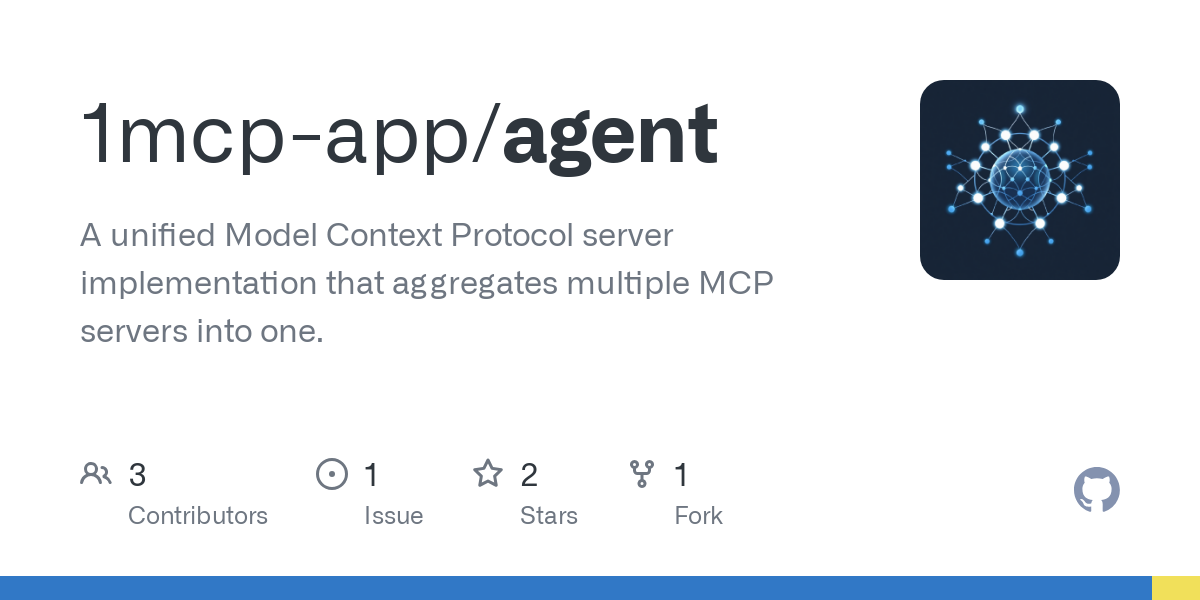1mcp_app_agent
by 1mcp-appOne MCP Server for AI Assistants
Overview
1MCP (One MCP) is a unified Model Context Protocol server implementation designed to simplify the way you work with AI assistants. Instead of configuring multiple MCP servers for different clients (Claude Desktop, Cherry Studio, Cursor, Roo Code, Claude, etc.), 1MCP provides a single, unified server that:
- Aggregates multiple MCP servers into one unified interface
- Reduces system resource usage by eliminating redundant server instances
- Simplifies configuration management across different AI assistants
- Provides a standardized way for AI models to interact with external tools and resources
- Supports dynamic configuration reloading without server restart
- Handles graceful shutdown and resource cleanup
Quick Start
To enable Cursor to use existing MCP servers already configured in Claude Desktop, follow these steps:
- Run the 1MCP server with the Claude Desktop config file:
npx -y @1mcp/agent --config ~/Library/Application\ Support/Claude/claude_desktop_config.json
- Add the 1MCP server to your Cursor config file (
~/.cursor/mcp.json):
{
"mcpServers": {
"1mcp": {
"type": "http",
"url": "http://localhost:3050/sse"
}
}
}
- Enjoy it!
Usage
You can run the server directly using npx:
# Basic usage (starts server with SSE transport)
npx -y @1mcp/agent
# Use existing Claude Desktop config
npx -y @1mcp/agent --config ~/Library/Application\ Support/Claude/claude_desktop_config.json
# Use stdio transport instead of SSE
npx -y @1mcp/agent --transport stdio
# Show all available options
npx -y @1mcp/agent --help
Available options:
--transport, -t: Choose transport type ("stdio" or "sse", default: "sse")--config, -c: Use a specific config file--port, -P: Change SSE port (default: 3050)--host, -H: Change SSE host (default: localhost)--tags, -g: Filter servers by tags (see Tags section below)--help, -h: Show help
Understanding Tags
Tags help you control which MCP servers are available to different clients. Think of tags as labels that describe what each server can do.
How to Use Tags
- In your server config: Add tags to each server to describe its capabilities
{
"mcpServers": {
"web-server": {
"command": "uvx",
"args": ["mcp-server-fetch"],
"tags": ["network", "web"],
"disabled": false
},
"file-server": {
"command": "npx",
"args": ["-y", "@modelcontextprotocol/server-filesystem", "~/Downloads"],
"tags": ["filesystem"],
"disabled": false
}
}
}
- When starting 1MCP in stdio mode: You can filter servers by tags
# Only start servers with the "network" tag
npx -y @1mcp/agent --transport stdio --tags "network"
# Start servers with either "network" or "filesystem" tags
npx -y @1mcp/agent --transport stdio --tags "network,filesystem"
- When using SSE transport: Clients can request servers with specific tags
{
"mcpServers": {
"1mcp": {
"type": "http",
"url": "http://localhost:3050/sse?tags=network" // Only connect to network-capable servers
}
}
}
Example tags:
network: For servers that make web requestsfilesystem: For servers that handle file operationsmemory: For servers that provide memory/storageshell: For servers that run shell commandsdb: For servers that handle database operations
Configuration
Global Configuration
The server automatically manages configuration in a global location:
- macOS/Linux:
~/.config/1mcp/mcp.json - Windows:
%APPDATA%/1mcp/mcp.json
Configuration File Format
{
"mcpServers": {
"mcp-server-fetch": {
"command": "uvx",
"args": ["mcp-server-fetch"],
"disabled": false
},
"server-memory": {
"command": "npx",
"args": ["-y", "@modelcontextprotocol/server-memory"],
"disabled": false
}
}
}
How It Works
System Architecture
graph TB
subgraph "AI Assistants"
A1[Claude Desktop]
A2[Cursor]
A3[Cherry Studio]
A4[Roo Code]
end
subgraph "1MCP Server"
MCP[1MCP Agent]
end
subgraph "MCP Servers"
S1[Server 1]
S2[Server 2]
S3[Server 3]
end
A1 -->|sse| MCP
A2 -->|sse| MCP
A3 -->|sse| MCP
A4 -->|sse| MCP
MCP --> |sse| S1
MCP --> |stdio| S2
MCP --> |stdio| S3
Request Flow
sequenceDiagram
participant Client as AI Assistant
participant 1MCP as 1MCP Server
participant MCP as MCP Servers
Client->>1MCP: Send MCP Request
activate 1MCP
1MCP->>1MCP: Validate Request
1MCP->>1MCP: Load Config
1MCP->>MCP: Forward Request
activate MCP
MCP-->>1MCP: Response
deactivate MCP
1MCP-->>Client: Forward Response
deactivate 1MCP
Development
Install dependencies:
pnpm install
Build the server:
pnpm build
For development with auto-rebuild:
pnpm watch
Run the server:
pnpm dev
Debugging
Using the MCP Inspector, which is available as a package script:
pnpm inspector
The Inspector will provide a URL to access debugging tools in your browser.
About
A unified Model Context Protocol server implementation that aggregates multiple MCP servers into one.

